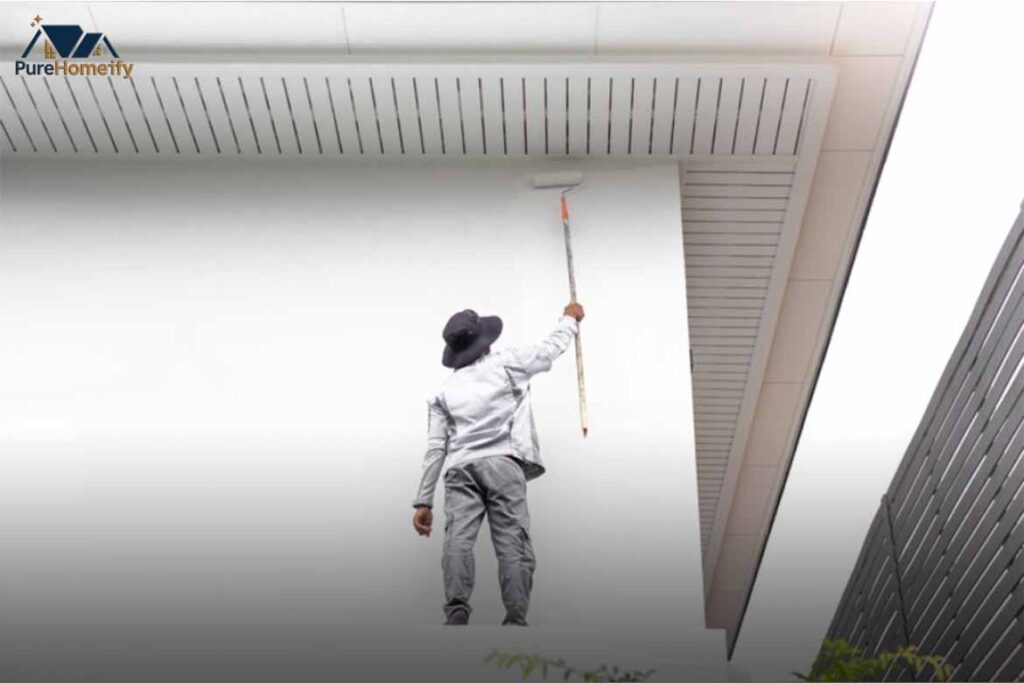Painting projects often bring up one burning question: can ceiling paint be used as primer? Many DIY homeowners in the USA think about skipping steps to save time or money. While it sounds tempting, this choice can affect the durability of paint job and the way your walls look in the long run.
To make a smart decision, you need to know the primer vs paint differences, understand ceiling paint composition, and learn when it is safe to use a ceiling paint substitute for primer. This guide explains it all with facts, examples, and even case studies from the field.
What Is the Difference Between Ceiling Paint and Primer?
The easiest way to compare is to look at what each product is made for. Ceiling paint composition includes high viscosity paint that helps reduce drips and mess when painting overhead. Its flat finish ceiling paint hides flaws well and creates a smooth and uniform finish. It also offers high hiding power paint, which means fewer coats when covering imperfections on walls.
A primer works differently. It is designed for sealing porous surfaces, improving adhesion and bonding qualities, and blocking stains and odors. For example, a stain-blocking primer or drywall primer is vital for new drywall preparation. Without it, you’ll risk blotchy and uneven finish and even peeling and flaking paint issues over time.
Can I Use Ceiling Paint as Primer?

So, can ceiling paint be used as primer in real projects? In some cases, yes, but only under limited conditions. If you are repainting old surfaces with the same color, ceiling paint may act like a quick base coat. Some DIYers even use it during glossy surfaces painting where a light refresh is needed.
But these situations are rare. Experts agree that primer vs paint differences are too big to ignore. Ceiling paint was never made to seal, bond, or stop stains. Skipping a proper primer might feel like a shortcut, but it often costs more later.
Things to Know Before You Start
There are some things to know before painting that can save you trouble. The first is proper surface preparation. Clean, dry, and smooth walls allow paint to stick better. Dust, grease, or moisture left on surfaces often leads to peeling and flaking paint issues.
Another fact is that not every wall or ceiling needs the same prep. new drywall preparation is different from repainting old surfaces. Wood, metal, or concrete each require a matching primer. Skipping this step can mean more coats, wasted money, and a poor finish.
Can Ceiling Paint Substitute for Primer?

Many ask if a ceiling paint substitute for primer is ever worth it. Sometimes, in a guest room or storage area, where durability isn’t critical, ceiling paint might hold up. If the old paint is solid and the new color is close, the job may look fine for a while.
However, when there are drastic color changes, stains, or glossy surfaces painting, ceiling paint fails. It cannot stop preventing bleed-through stains or seal porous areas. That is why professionals rarely recommend it, except in small, low-impact projects.
Advantages of Using Ceiling Paint as Primer
The biggest benefit of using ceiling paint is cost. It can feel like a cheap fix, especially if you already own some paint. Its high hiding power paint can also help when covering imperfections on walls during quick jobs.
Another plus is convenience. You avoid buying extra products and reduce time. For small DIY tasks, this may seem like a smart move. Still, the cost-effectiveness of using primer in the long run is usually better.
Drawbacks and Limitations You Should Consider
The weaknesses are clear. Ceiling paint lacks strong adhesion and bonding qualities, which leads to peeling and flaking paint issues. It also can’t block stains, making blocking stains and odors impossible without a stain-blocking primer.
Ceiling paint is also weak on new drywall preparation. Without primer, the surface absorbs paint unevenly. The result is a blotchy and uneven finish that looks unprofessional and often requires costly repairs.
Why It’s Best to Use a Dedicated Primer
Primers are built for performance. A bonding primer grips slick surfaces, while a multi-surface primer works on many materials at once. This ensures strong adhesion and bonding qualities, reducing future failures.
They also offer stain protection. A stain-blocking primer locks in smoke, grease, or water marks. This prevents bleed-through stains that even the best flat finish ceiling paint cannot hide.
Best Practices for Painting Preparation

Good prep sets the stage for success. Knowing when to use primer is vital. Use it on new drywall preparation, dark-to-light drastic color changes, or where stains exist.
Professional tips for painting always include cleaning, sanding, and priming. Even with ceiling paint, skipping these steps causes problems. Good prep ensures a lasting durability of paint job and a clean, attractive look.
In Our Experience
Real-world cases prove the point. In one project, we tried using ceiling paint on repainting old surfaces in a hallway. At first, it looked fine. Within months, peeling and flaking paint issues showed up, proving the shortcut wasn’t worth it.
By contrast, when we used a multi-surface primer on glossy surfaces painting, the topcoat bonded perfectly. The finish stayed solid for years, showing how much better adhesion and bonding qualities work with proper primers.
When to Call in the Pros
Sometimes, DIY isn’t enough. When to call in the pros is when you’re facing smoke stains, water marks, or damaged walls. Complex surfaces need skill and products like bonding primer or stain-blocking primer.
Companies like Lightman Painting offer expert help. With professional painting services Portland Oregon, they know which primer works best, and they follow strict proper surface preparation steps for lasting results.
Best Alternatives to Ceiling Paint as Primer
Instead of using ceiling paint, choose a product made for the job. A drywall primer is perfect for new drywall preparation, while a stain-blocking primer helps with smoke or water damage. For tricky surfaces, a bonding primer ensures better grip.
A multi-surface primer works well when your project involves mixed materials. These options prevent blotchy and uneven finish, make covering imperfections on walls easier, and improve the cost-effectiveness of using primer in every project.
Conclusion: Should You Use Ceiling Paint as Primer?
So, should you rely on ceiling paint instead of primer? In most cases, no. While it may serve as a quick fix in small spaces, it cannot match the durability of paint job a real primer delivers.
For USA homeowners who want lasting results, using a true primer is the smarter choice. Investing in one prevents peeling and flaking paint issues, improves finishes, and ensures long-term savings. When in doubt, trust professional tips for painting or reach out to experts like Lightman Painting for guidance.
FAQs
What happens if you put ceiling paint on walls?
Ceiling paint on walls will look flat and may hide small flaws, but it won’t last long in high-traffic areas. It can lead to peeling, stains showing through, and a dull, uneven finish.
Is ceiling paint a good undercoat?
Ceiling paint can act as a temporary undercoat in low-use spaces, but it lacks bonding and stain-blocking qualities. A proper primer is always the better choice for durability.
Do I need to prime before using ceiling paint?
Yes, priming is necessary for new drywall, drastic color changes, or stained surfaces. Skipping primer often causes poor adhesion and blotchy results when using ceiling paint.
Can I use paint instead of primer?
Paint and primer serve different purposes. Paint provides color, while primer seals, bonds, and blocks stains. Using paint instead of primer usually leads to a weak finish.
What should I use if I don’t have primer?
If you don’t have primer, a multi-surface paint-and-primer-in-one can work as a backup. Still, a dedicated primer will give you stronger adhesion, better stain-blocking, and a longer-lasting paint job.

